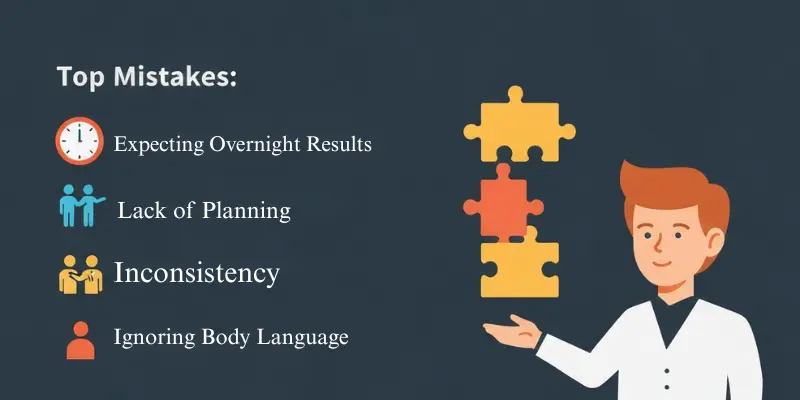NLP exercises in Neuro-Linguistic Programming (NLP) help build confidence by changing how you think and feel about yourself. Through exercises like anchoring positive emotions, visualizing success and reframing negative thoughts, you can train your mind to respond with confidence instead of fear. Practiced daily, these techniques create genuine self-belief and emotional strength that lasts.
Confidence isn’t something you’re born with; it’s something you build and reinforce every day. Many people struggle with self-doubt, negative thinking, or fear of failure that holds them back. This is where Neuro-Linguistic Programming (NLP) comes in. NLP helps you reprogram the way you think, speak, and respond to challenges, allowing you to create the mindset of a confident, capable person.
In this article, we’ll explore how NLP works, the most effective daily exercises for building confidence, and how you can make them a consistent part of your life.
Key Takeaways
- NLP rewires your thoughts, emotions, and body responses for confidence.
- Daily techniques like anchoring, visualization, and reframing help eliminate self-doubt.
- Confidence grows from repetition; short, consistent practice is most effective.
- NLP also enhances emotional intelligence, leadership, and mental clarity.
Understanding NLP and Its Role in Confidence Building

Neuro-Linguistic Programming (NLP) is based on the idea that your words (linguistics), thoughts (neuro), and actions (programming) shape your reality. By changing how you think and speak, you can change how you feel and behave. Confidence is largely a result of internal dialogue and mental imagery and NLP gives you the tools to shift both.
For example, when you replace “I might fail” with “I’m prepared and capable,” your brain starts creating emotional states aligned with success. Over time, this rewiring strengthens your self-belief and performance.
Most Effective NLP Exercises for Daily Confidence Building
Confidence isn’t something you’re born with; it’s something you train your mind to create. NLP (Neuro-Linguistic Programming) offers simple yet powerful techniques to rewire self-doubt into self-belief. With daily practice, these exercises can help you stay calm, focused, and confident in any situation.

Anchoring Positive States
Anchoring links a confident emotional state with a physical trigger, like touching your wrist or taking a deep breath.
How to do it:
- Recall a time when you felt truly confident.
- Close your eyes and relive it vividly, notice how your body feels.
- While fully immersed, touch a specific point (like pressing your thumb and finger together).
The Swish Pattern
This NLP visualization technique replaces anxiety or self-doubt with confidence.
How to do it:
- Visualize your nervous self vividly (e.g., slouched posture, tense face).
- Then, imagine a brighter, more confident version of you standing tall and calm.
- Mentally “swish” the two images and make the confident one quickly replace the nervous image.
Reframing Negative Self-Talk
Your inner dialogue shapes your confidence more than any external factor.
How to do it:
- Write down recurring negative thoughts (“I’m not good enough,” “I always mess up”).
- Replace them with empowering versions (“I’m learning every day,” “I handle challenges calmly”).
This mental reframe changes how your brain processes failure and success.
Visualization for Success
Visualization is one of NLP’s most effective tools for building lasting confidence.
How to do it:
Before any challenge, close your eyes and picture yourself succeeding, speaking confidently, smiling and staying composed. Feel the emotions of success.
Your subconscious doesn’t distinguish imagination from reality, so this repeated visualization programs your mind for confident behavior in real-life moments.
Modeling Confident People
NLP suggests that if someone else can achieve confidence, you can too by replicating their mindset and actions.
How to do it:
- Observe someone confident (a speaker, leader, or mentor).
- Study how they move, speak, and handle pressure.
- Practice those behaviors daily until they become natural.
This helps you adopt not just the posture but also the mindset of confidence.
The Circle of Excellence
This NLP exercise helps you step into a “state of confidence” anytime you need it.
How to do it:
- Imagine a glowing circle in front of you.
- Fill it with feelings of strength, calmness, and energy.
- Step into the circle, breathe deeply, and feel the emotions surround you.
Use this before important moments to instantly boost your confidence.
Common Mistakes to Avoid

Even with the best NLP techniques, certain habits can block your progress. Here are the most common ones to watch out for:
Expecting Instant Results
Confidence doesn’t happen overnight. NLP works through repetition and consistent practice. Treat it like building a muscle; it strengthens gradually with daily effort and patience.
Being Inconsistent
Skipping practice breaks your momentum. The subconscious mind learns through routine, so regular visualization, reframing, or anchoring is essential. Even five focused minutes a day can create lasting change.
Ignoring Body Language
True confidence isn’t just mental, it’s physical too. Slouched posture or a low tone can undermine your mindset. Stand tall, make eye contact, and use open gestures to reinforce inner confidence.
FAQs
How long does NLP take to build confidence?
You’ll start noticing results within a week or two, but consistent daily practice for 3–4 weeks makes confidence more natural.
Can I practice NLP alone?
Yes, most NLP exercises, like visualization and anchoring, can be done on your own. Coaching sessions can deepen the results if needed.
Are NLP exercises safe and effective?
Absolutely. They are mindset-training tools based on psychology and language patterns, safe for all ages and professions.
Can NLP help with public speaking or interviews?
Yes! Visualization and anchoring techniques are especially powerful for calming nerves and boosting confidence before public events.
Conclusion
Building confidence through NLP isn’t about pretending to be someone else; it’s about rediscovering the strong, capable version of yourself that already exists. These simple yet powerful daily exercises help you align your thoughts, language, and emotions to create the confidence you’ve always wanted.
When practiced consistently, NLP becomes more than a tool; it becomes a mindset. You’ll start walking, speaking, and living with self-assurance that feels natural and effortless. Confidence, after all, is not built overnight; it’s built one thought, one action, and one belief at a time.





